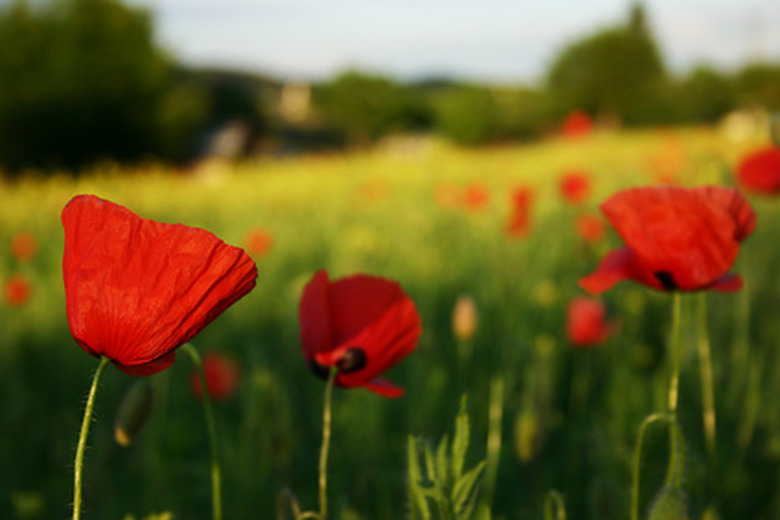Flowers Native To Poland
Native flowers of Poland are often found growing in the wild throughout most of eastern Europe. While the majority of these flowers are now commonly found in the United States, they were first introduced from European countries, including Poland. Native Polish flowers tend to grow easily both in the wild and in cultivated gardens, dotting the landscape with bright splashes of color.
Corn Poppy
Corn poppy (Papaver Rhoeas), also known as Flanders poppy, is native to Europe and is named for its tendency to flourish in fields of cereal grains, such as wheat or corn. Corn poppy is also the national flower of Poland. This annual plant grows easily with minimal care. It is often classified as a weed due to its rapid growth and subsequent tendency to hinder the growth and production of grain plants, according to the Georgia Department of Agriculture. Beginning in the spring, bright red flowers bloom, and blossoming continues until the first frost. Corn poppy grows well in moist, well-drained soil and partial shade. This plant is hardy to USDA planting zones 3 to 9.
- Native flowers of Poland are often found growing in the wild throughout most of eastern Europe.
- Corn poppy (Papaver Rhoeas), also known as Flanders poppy, is native to Europe and is named for its tendency to flourish in fields of cereal grains, such as wheat or corn.
Siberian Iris
Siberian iris (Iris sibirica) is a native plant of eastern and central Europe. Siberian iris begins to bloom in the late spring, producing flowers in a wide array of colors, including white, yellow, pink, purple and blue, according to the University of Minnesota. Flowering continues throughout the summer. As its name suggests, the Siberian iris is extremely cold hardy. This plant grows quite easily and is able to tolerate damp and wet locations, although moist, well-drained soil is optimal. Hardy in USDA planting zones 3 to 8, Siberian iris thrives in full-sun conditions.
Globe Flower
Globe flower (Trollius europaeus), a member of the buttercup family, is native to Europe and western Asia. Beginning in the early spring and continuing into the summer, this plant blooms tightly bunched, bright yellow flowers. Globe flower requires consistently moist to wet soil, as well as partial shade, according to the Plant-Biology.com. Globe flower will bloom continuously if dead-headed. Commonly found in the wild along riverbanks and open woodlands, this plant is hardy in USDA planting zones 4 to 8.
- Siberian iris (Iris sibirica) is a native plant of eastern and central Europe.
- Globe flower requires consistently moist to wet soil, as well as partial shade, according to the Plant-Biology.com.
Annual Baby's Breath
Annual baby's breath (Gypsophila elegans) is native to eastern European countries. This plant is popular for its long bloom time, as well as its longevity once cut. Flowers are tiny and white and tend to grow in clusters. Annual baby's breath begins to produce flowers in early summer and continues to bloom until the first frost, according to WildflowerInformation.org. This plant grows easily with little maintenance and flourishes in full sun with moist, well-drained soil. Annual baby's breath is hardy in USDA planting zones 3 to 10.
